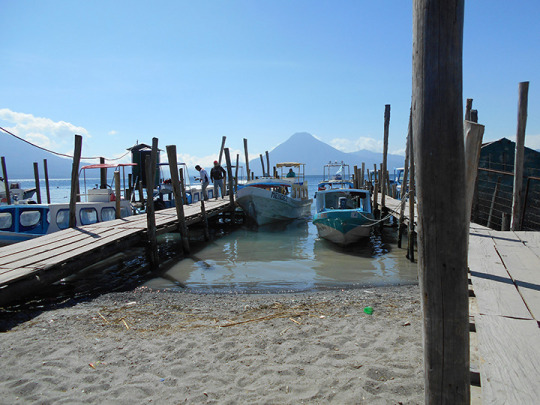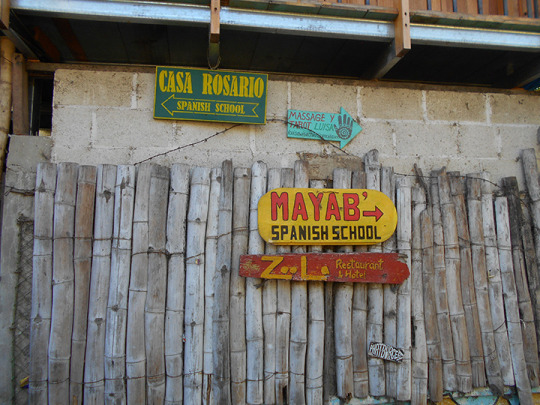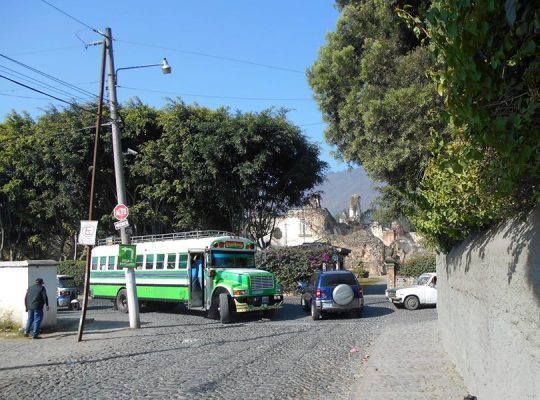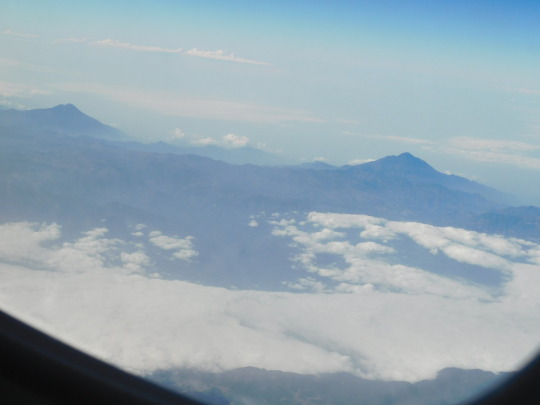Text
Going to Guatemala. Part I
As recently as three years ago, it would never have occurred to me that I would come to love a small country in Central America known as Guatemala. It’s a love affair that began with watching travel videos on youtube.com and culminated with a ten day visit in January of 2018, followed by a three week visit in February of 2019. The youtube videos in question were made by a trio of young people called The Budgeteers and, to a lesser extent, by a man named Andy Graham who has his own website called hobotraveler.com. Prior to watching these videos, I suppose I must have just lumped all Latin American countries into one homogeneous mass of poverty, corruption and CIA meddling. Watching The Budgeteers hitchhike their way from Baja, California to the San Blas Islands, just off the coast of Panama, I realized that every Central American country is actually a little different. My original idea for 2018 had been to do what many Canadians do in the bleak winter months of January and February, to spend a week to ten days in Cuba. But the more I looked into Cuba, the more it seemed to me to be a country which is presented to tourists as a kind of Caribbean idyll, when in fact the truth is far from what you see on the surface. Guatemala, on the other hand, appeared to be a country where people are simply living their lives and don’t care all that much about tourists unless they happen to live in Antigua, one of the touristy towns around Lake Atitlan or Chichicastenango. In the rest of the country, people seemed to making a living from farming or by owning their own store. There are, in fact, so many tiendas in Guatemala that it is hard to imagine finding a place where there isn’t one. The point is that most Guatemalans don’t go out of their way to please tourists and they certainly don’t alter their behaviour to present a pleasing picture to the outside world.
The other vlogger who caught my attention, Andy Graham, did so because he has a number of videos of himself standing in front of Lake Atitlan saying, “Panajachel, Guatemala. I’m here. You’re not. Why not?” Mr. Graham’s shtick is that he has lived in 181 countries all over the world and can tell you how to live the same lifestyle he does, if you so wish. I won’t go into it any further than that, but suffice it to say that his assertions about Panajachel and Lake Atitlan being desirable places to head for if you wanted to live abroad were enough to make me open the Google maps Street View feature and start looking around. What I saw astonished me. Far from being a dreary, downtrodden backwater, Panajachel seemed to be bursting with life and colour. Souvenir shops selling multi-coloured clothing competed for room with open air restaurants and bars. Bright red Tuk-tuks, motorcycles and minivans somehow managed to share the narrow street with tourists and Guatemalan women selling their wares. A solid kilometer of interesting things to see, do and just be fascinated by. I decided that I had to go to Guatemala at least once in my life, if for no other reason than just to walk down Santander Street.

The view out the window at Pearson Airport the day I left.
I began planning my first visit in earnest when I realized that a return plane ticket on Air Mexico would only cost in the neighbourhood of $450. That would include a one day layover in Mexico City, but I was fine with that. Why not look around there too for a day? I managed to find a hostel that was only a 20 minute walk from Terminal 1 at Benito Juarez Airport. The only potential hiccup was that Air Mexico flights from Toronto land at Terminal 3 and, while there is a free Sky Train to Terminal 1, I had read that you need to show your boarding pass to get on it. I, of course, had a boarding pass, but it didn’t carry with it any express need to go to the other terminal. It turned out not to matter. Despite the fact that the security guard at entrance to the Sky Train boarding area was overtly hostile, as soon as I showed her my defunct boarding pass, she let me go through. Seriously, what do these people think? That gringos who just happen to live in Mexico hang around in the airport all day with nothing better to do than ride the monorail back and forth from one terminal to the other? In any case, I made it to Terminal 1 and managed to find my way to the far western end of it, where the footpath to my hostel began.
I had looked it up on Google Maps, but I wasn’t a hundred percent sure it could be done, by which I mean getting across the very large and very busy, multi-lane highway that essentially cuts off the airport from the adjacent neighbourhood. The Circuito Interior is a 42 kilometer long, six to eight lane freeway that forms a giant loop through the central neighbourhoods of the city. Fortunately, my hunch proved to be correct. There is a footpath, which leads to an overpass (i.e. footbridge), which deposits you on the other side of the freeway at the foot of the street, Norte 33, which, in turn, leads to the hostel. The service road, beside the Circuito is lined with airport hotels, fast food joints, car rental agencies and all the other sort of shops one typically associates with airports. In behind it, however, is a solidly working class, blue collar neighbourhood. This is where old VW beetles go to die. I saw three or four of them, at least, just in the short walk to the hostel, not actual working cars, mind you, just burned out shells of cars that had long ago been parked on the street and forgotten about. Clearly, the intention was to fix them up but it was an intention that, for whatever reason, was never followed through on. So there they sit, the unrealized dreams of anonymous Mexicans.

An old Beetle in Barrio Moctezuma.
Nevertheless, this is a neighbourhood that is full of life. Tiendas, restaurants and food stands line the streets. A large sports complex, complete with a soccer pitch and three basketball courts has been plunked down right in the middle of it. Around the walls of this complex are more street food stalls, fruit stands, miniature shrines where you can make an offering to the Virgin Mary (presumably to help your team win the soccer match).
If you should decide one day to stay at Punto DF, what follows is a short description of how to get from the footbridge to the hostel. Heading north, it is tempting to think you should stay on Norte 33 until you get to 166 Calle Oriente, and the cut over to the hostel, but it is much more interesting to hang a left on Calle Oriente 182 and walk over to Norte 25. This is where, to my mind the neighbourhood comes alive. Norte 25 is an absolutely unpretentious and, at the same time, lovely grand avenue with a line of small trees down the middle. A paint store sits next to the local stationary shop. Sidewalk eateries or comedors tell you that this is a place where people actually live and, to quote Van Morrison, have their being. Calle Norte 25 appears to come to a halt at Moctezuma and Fortino Serrano Parks (two parks side by side that are in effect one park), but it actually continues along the southwestern edge of these parks and resumes again on the northwestern side of Fortino Serrano. You could, of course, just walk through the park to get to the point where it starts again. From the corner of Calle Oriente 168 and Calle Norte 25, it is only one block further to Calle Oriente 166, the street Punto DF is on. Cocina Don Pepe has an orange awning. Turn left there. A large colourful mural will let you know you have found the right place.
My plane was two hours late, but it was still only about eleven in the morning when I rang the doorbell and was greeted by a very nice young man (I think his name might have been Francisco) who didn’t mind at all that I was checking in so soon. Of course, all I wanted to do was put my knapsack in one of their lockers and head downtown to see a bit of the city. Francisco gave me a map of the subway and confirmed that the cost was indeed five pesos. (It’s now six pesos, but that’s still less than fifty cents Canadian.) The Metro station nearest to Punto DF is R. Flores Magnon. It’s one of the more utilitarian stations in the system and is named after an anarchist who helped spark the Mexican Revolution. To get to it, you simply continue up Norte 25, navigating your way around the sports stadium and Mercado Moctezuma. If you’re feeling adventurous, you can cut through a pedestrian pathway that is actually part of the market. It’s just to the right of the low lying, yellow building that says Mercado de Moctezuma.
Moctezuma, as you probably know, was the ruler of the Aztecs at the time of first contact and he died on July the 1st, 1520 from being hit on the head with a rock thrown by a member of the Aztec uprising, because he was thought to be behaving in a way that was too conciliatory to the Spanish. They had, after all, massacred a large number of men, women and children in the great temple just ten days earlier. Another version of events claims that Moctezuma’s dead body–along with that of another Aztec king, Itzquauhtzin–was simply cast out of the palace once it became clear that he did not actually have the ability to stop the Aztec uprising.
At the far end of the laneway, you will emerge on Calle Oriente, just a short bit to the left of where Calle Norte 25 continues. Here there are more cafes, tiendas, stores to buy school uniforms, stationary shops, sidewalk food vendors, beauty shops and tortillerias lining both sides of the street as it leads up to the Metro. If you’ve never been on the Metro before, brace yourself. It isn’t even remotely close to the being like a ride on the TTC or whatever type of public transit you may have experienced in the States, Canada or even Europe. R. Flores Magnon, however, is a fairly mild introduction, in that it’s not very crowded. Just find your way up the stairs, buy a ticket at the booth, feed it into the turnstile, make sure the train is going in the direction you want and you are good to go, so to speak. One of the first things you will notice is that the cars are old. They were built by Bombardier, or at least some of them were, back in the late sixties and early seventies. Bombardier is the Canadian company that keeps getting its contracts cancelled by Toronto’s public transit system, due to its inability to deliver vehicles on time and to spec, but in this case, they seem to have done alright since these forty-year-old cars are still running. The next thing you might notice if you take the Metro at any time of day that is even close to rush hour is that these cars fill up fast. Mexico City’s population, if you take into account the whole metropolitan area, is 21 million, and a lot of those people use the Metro to get around. Nevertheless, it is relatively easy to negotiate and I was able to make my way to the station I wanted, San Juan de Letran, without too much difficulty.
My plan had been to land myself somewhere central and just sort of wander around, but I quickly realized how easy it would be to get lost in a city where no-one speks the same language as you. Eje Central Lazaro Cardenas is a large, bustling, multi-lane avenue, lined with shops of all kinds, and it also leads up to the Palacio de Belles Artes. You can probably figure out for yourself that this means Palace of Fine Artes.
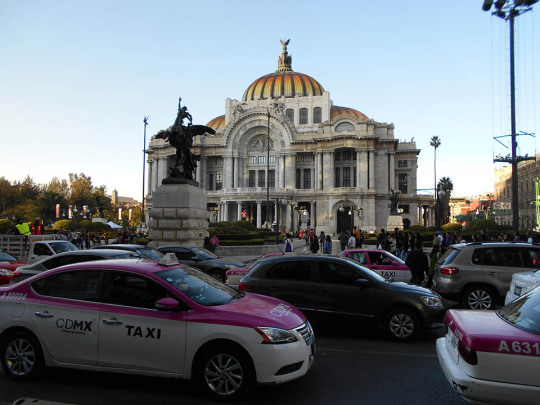
Palacio de Belles Artes
It’s an absolutely awesome building that I wished I had time to explore further, but I didn’t, so I satisfied myself with sitting in the park beside it, Almeda Central. It’s a large park, with water fountains, trees and places to sit. At the eastern end is the palacio. On the northern side is Teatro Hildago and the National Stamp Museum, while on the western end, there is an art museum with a mural by Diego Rivera. I dare say you could spend three or four days just exploring the different buildings around this park but I didn’t have much more than an hour to just sit and contemplate my surroundings. It can be a bit of a shock to the system to get on a plane in a city where the snow is a foot deep and seven hours later find oneself surrounded by trees and water fountains in a space where people are just hanging out and enjoying the warm weather.

Almeda Central
I can’t say that I thought much more about it than that. Mexico City seemed a little on the inscrutable side, hard to understand and/or grasp the spirit of and I wasn’t going to have enough time to more than scratch the surface. I decided to fulfill my goal of seeking out a fish taco place I had read about on the internet.
El Pescadito is a chain of restaurants in Mexico City that only sells fish tacos. The one I was headed for is quite close the park, just one block south on Luis Moya and half a block to the right on Avenita Independencia. I really had no idea how to order because my Spanish was very limited at that point in time, but I somehow managed to muddled through and obtain a shrimp taco, a fish taco and a beer. The process, just in case you ever find yourself inside one of these places, is you order from the cook and sit down. Then someone brings the food to your table at which point you can take your tacos to the salsa table, where there are about ten different choices. Unlike most chains, you pay when you’re done. I sat looking out the window and watched a man using some kind of clay to remake the sidewalk curb, by hand. Basically, he made a cast from wood planks, poured the clay into it and then smoothed out the top with a trowel. I had the impression that he was some kind of private contractor, not a city employee, and I enjoyed watching him work while I ate my fish and shrimp tacos. Soon enough it was time to leave and begin making my way back to the hostel.
I was about to acquire a whole new appreciation for the term packed in like sardines. The trains on the Mexico City Metro become so full of people at rush hour that you find yourself pressed in on all sides and virtually unable to move. And just when you think that not one more person can press his way inside, someone manages to do just that by letting the doors close on him repeatedly until he is literally squeezed through the doorway. I began to grow concerned that I would not be able to get off at my station without bowling over several people first. Fortunately, after wracking my brain to find the Spanish version of “excuse me”, I came up with “permiso”, and that worked. People actually shifted to one side long enough for me to edge my way through them and get out the door and onto the platform of R. Flores Magnon Station.
It was later than I had thought and Barrio Moctezuma was already dark. I was a little nervous because I had read a TripAdvisor posting about my hostel which said that the poster wasn’t sure it was a safe neighbourhood to be walking alone through at night. Those feelings quickly dissipated as I realized there were still plenty of people dining in restaurants, going to the tiendas and just hanging out with friends on the street corners. Some houses had LED Christmas lights on them, giving the whole neighbour a soft glow.
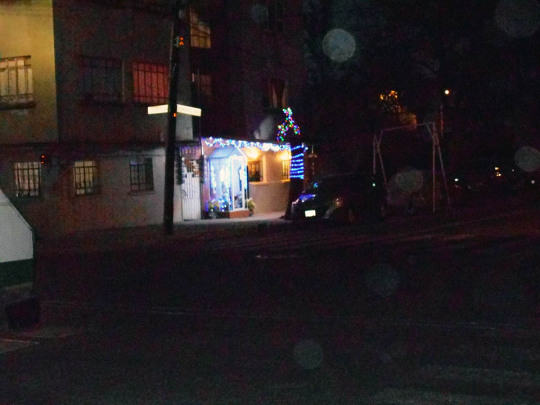
Barrio Moctemzuma at night.
I saw a brightly lit store called, appropriately enough, La Luz 1. It had a bottle of beer on its sign, so I reasoned that they probably sold beer and decided to pick up a few to drink on the hostel patio. After stepping inside and giving the place a quick scan, I found that the owner was stationed behind a cage of half-inch, white bars. There was a fridge to my right with beer in it, but when I tried to open the door, I found that it was locked. The man behind the counter came out, unlocked it for me and went back inside his cage. I took three Coronas to the counter with no idea what they would cost. When he told me the price, in Spanish, I found that I couldn’t understand him and gave him my notebook to write the price on, but he had a better idea. He produced a calculator and showed me the price on that. I left feeling quite pleased with myself for having successfully navigated my first purchase in a Mexican store, not including, of course, my meal at La Pescadito. That didn’t count because in that restaurant the prices are posted on the wall in large letters and numbers. In the store, I had to ask “Cuanta Cuesta” and try to understand the answer.
Back inside the hostel, I found Francisco still on duty and I asked, needlessly, if it was okay to drink beer on the patio. Many hostels in Latin America have beer for sale right on the premises, but I didn’t know that then, and in any case, Punto DF does not. He told me that of course it was okay, so I made my way out the back door and sat in the open air with nothing on my back but a short sleeved cotton, enjoying my beers and listening to the sounds of the barrio; the occasional car engine revving, a dog bark here and there and, of course, the far away sound of airplanes taking off and landing. Cognizant of the fact that I would need to leave the hostel at 7:00 AM if I was to be at the airport three hours before my flight, I stowed my knapsack in one of the lockers, crawled into the cubbyhole which contained my bed, pulled the curtain closed, got undressed and quickly fell asleep.
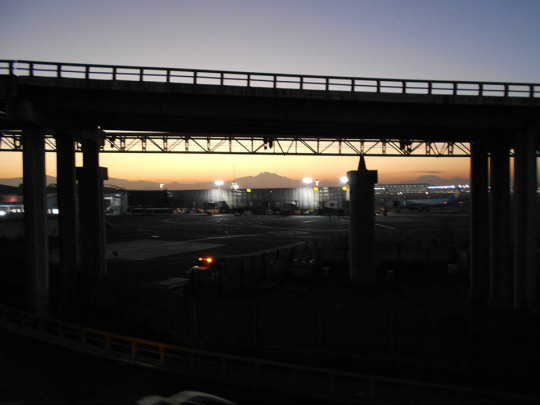
Approaching Benito Juarez Airport early the next morning.
-------------------------------------------------------------------------------------------
To purchase Going to Guatemala as an instant download PDF, click here.
To visit Lost City Press, click here.
To continue to Part II, click here.
0 notes
Text
Going to Guatemala. Part II
It isn’t really necessary to be at the airport three hours before your flight when you already have your boarding pass and don’t intend to check any luggage. Nevertheless, I rose early the next morning, performed my ablutions and left Punto DF without taking advantage of the free breakfast. It wouldn’t have been ready for another hour anyway. The streets of Barrio Moctezuma were not as empty as one might expect them to be at such an hour. Many food vendors were already in operation, doling out coffee and tortillas to their small coteries of customers. The sun was just beginning to come over the top of a distant volcano, the name of which I don’t know, Iztaccihuatl perhaps. I made my way across the footbridge and once again rode the Sky Train back to Terminal 2. It was too early for my flight to have been assigned a gate, so the departures board only said that I would be leaving from gate L. I passed some time looking at an art exhibit that had been installed in the middle of the terminal. It consisted of some rather odd, almost troll-like figures dressed in lab coats. They were wearing gas masks and staring at a light on the floor, which changed colour every thirty seconds or so. I don’t think it would be unfair to categorize it as kitsch. Judge for yourself.


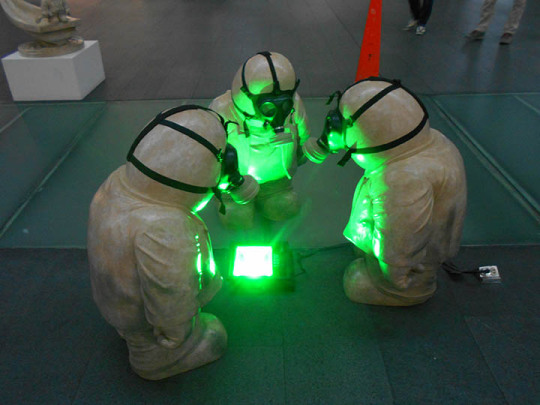
Wandering to far end of the terminal, I heard some yelling coming from the level below. It was, I think, a group of government employees protesting unfair wages. They chanted away in Spanish for about twenty minutes and then left. While I was watching, I happened to notice that the lower level had some fast food joints, including a Carl’s Jr. So when the protest was over, I went down the escalator and bought a breakfast sandwich.
The landside of Terminal 2 doesn’t really have much to offer in the way of amusements, so I basically just killed time by walking back and forth from one end of the hall to the other until my gate number finally came up on the departures board. It said my flight was “on time”, but it always says that until about half-an-hour before departure. I successfully navigated the security scanners and walked out into the airside part of the terminal. Things are a little more interesting there, with currency exchange booths, duty free shops, bars and restaurants, all of which are, naturally, insanely overpriced. The departure lounge branches off in three different directions, and the lounge for my gate was down a long ramp and then an escalator. I realized, as I looked around, that my plane would not be boarding anytime soon. There was no plane docked at the gate and the check-in staff were not making any effort to pre-process people.
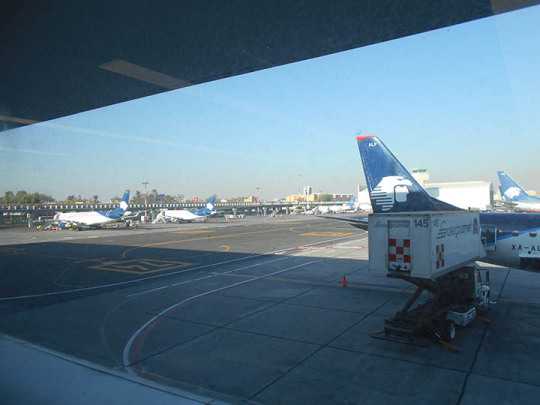
I watched the departures board as my flight changed from “on time” to “delayed”. Several announcements were made on the PA system, but they were unintelligible in both Spanish and English. An hour-and-a-half after the scheduled departure time, a plane finally pulled up to the docking bay. Half-an-hour after that, the pilot and the rest of the crew appeared. The check-in staff swung into action and we were all process quickly and with no fuss. Another ramp, a long tunnel and I was on the plane. The stewardess inside the door to the plane appeared to be not quite all there for some reason, but I greeted her anyway with, “Buenos tardes”, Spanish for “Good afternoon”. She seemed almost stunned that I had spoken to her, but she returned the greeting.
It was a much smaller plane than the one from Toronto to Mexico City, but still large enough to inspire confidence. My window seat was almost over the wing, and that, I have read, is the safest part of the plane. As soon as everyone was onboard, we pulled away from the terminal and began taxing towards the runway. The takeoff felt smooth and effortless. Soon, I was high above the Mexican countryside, looking down on the mountains and volcanoes which surround the pueblos in the southern part of the country.
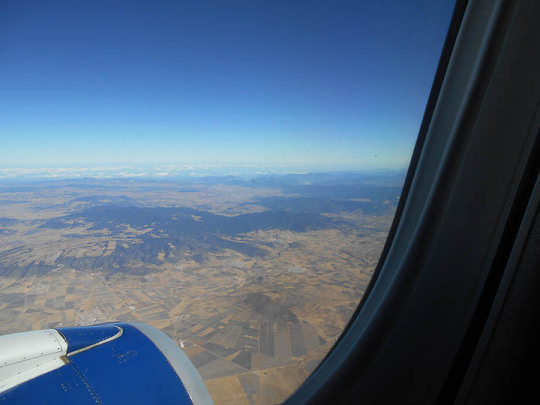
One thing I can say about Aeromexico is that they feed you half-decently. I hadn’t eaten since the morning and it was then about 2:30 in the afternoon, so the ham and cheese sandwich hit the spot. There were a few other things included, a small salad and some kind of pudding. With food in my belly, there was nothing to do but gaze out the window at the Guatemalan countryside far below. It’s only an hour-and-a-half flight from Benito Juarez to La Aurora International Airport. The time passed quickly even though here was no inflight entertainment. I spent my time filling out the immigration form that the stewardess had distributed and, after that, just looking out the window for signs that we were descending. Soon enough, a series of large mountains appeared, and then the sprawling suburbs of Guatemala City. We circled around to the south end of the city and began our descent. La Aurora, like Benito Juarez, is surrounded by houses, and it can be a little disconcerting to see them so close to your plane, but we landed without incident and began taxiing towards the terminal. One thing you notice right away about this airport is that some old planes from the 1950s have been shunted off to the far edge of the landing field and left to rust. Another is that the city is not very far away from a large volcano. I think it is called Pacaya, which is also the name for a type of small palm plant that Guatemalans eat. The place was reminiscent of some frames from the graphic novel,Tintin and the Picaros, although that takes place in the mythological South American city of Tapiocapolis.
Another thing you notice is that La Aurora is small. There are rarely more than two planes docked at the loading bays, and no long line up of planes waiting to take off. When you disembark, there is a fairly lengthy walk to immigration and signs telling you that money laundering will be severely punished. Eventually, you come to immigration, where the first thing you are asked to do is push a large red button that is connected to some kind of random number generator. There are two lights above it, a green one and a red one. If the green one lights up, you can proceed straight to immigration without having your bag checked. My light was the red one so I had to place my knapsack on a counter and open it. A youngish man gave it a cursory examination and told me to proceed. The immigration officers don’t talk. You simply hand them your form and your passport. They take a quick glance at the form, open your passport to the visas page and stamp it. This is a critical point if you are planning to stay for more than a month. They are supposed to write 90 days inside the stamp’s blank area, but I have heard that sometimes they only allow you 30 days. If so, you’d better hope that your Spanish is good enough to ask for an explanation. They’ve probably just made a mistake and need to correct it. Canadians and Americans are entitled to stay for 90 days without renewing their visas.
After getting through immigration, you find yourself in an odd little foyer with booths selling shuttle bus rides and taxis to Antigua. I made the mistake of walking right through this area and out the doors to the area where there are usually about a hundred people waiting to meet their loved ones. Then I made the mistake of asking a guy, who wanted to sell me a taxi-ride to Antigua where the shuttle buses were. He pointed towards the ramp leading away from the arrivals area and said, “Somewhere over there. It’s quite far.” I didn’t believe it could be very far and, in fact, it wasn’t because as soon as I was a hundred feet up the ramp, he began yelling at me to come back. He told me I could get a shuttle bus ticket, the going price for which is ten US dollars, at one of the booths back inside the odd foyer area. I went back inside, asked a man where to go and was told to follow him to one of the booths. It turned out I had asked the right person, because he took my ten dollars and handed me a receipt. “We just have to wait for one more person because those two over there going with you.” The two over there were a young couple who hadn’t actually made up their minds because the young man was in the process of explaining to his girlfriend that they couldn’t afford a taxi all to themselves. People were still in the process of clearing customs, however, and within a few minutes another young man purchased a ticket. The sales agent then led us all back outside and handed us over to the care of a taxi driver, with a very small car. Almost all the taxis in Guatemala are very small because gas is expensive and they don’t charge very much. A ride to the downtown core, for example, is $14 Canadian, or 70 Quetzals. Luckily, I got the passenger side seat. Unluckily, it was pushed so far forward that I barely had room for myself and my knapsack. There was no room for my knapsack in the trunk, because the charming young lady had immediately jammed her oversize suitcase into it. My knees were pushed up against the glove compartment and my feet were jammed into a fixed position on either side of my backpack. The driver put the car in gear and started our journey with what was at first a fairly leisurely pace.
As we drove through the streets of southern Guatemala City, I got my first taste of what the country was like. Broad tree-lined avenues alternated with narrow streets where the houses and stores were painted with every colour imaginable. There were women on the sidewalks, many of whom were women dressed in traditional, multi-coloured dresses, blouses and skirts. The streets teamed with traffic, ancient Toyotas vied for space with late model SUVs and motorcycles and many, many motorcycles. And on every street, fume belching, dirty, red buses, the ones that travel guides tell you not to get on unless you’re desperate because the chances of getting robbed are too high.

At first, our driver seemed to be taking a rather circuitous route, but, as I later realized, he was simply looking for an easy way to get on the freeway. Eventually, he managed to do just that and we quickly became part of a sea of bumper to bumper traffic.
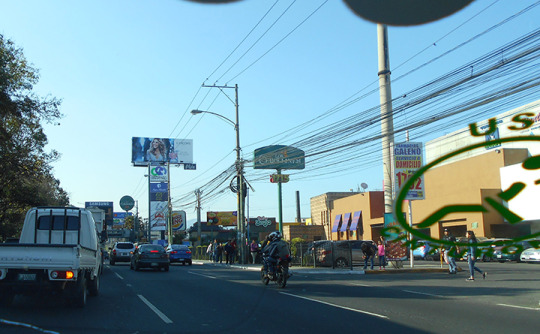
It was a multi-lane freeway, divided by yellow, concrete barriers, the kind that are supposed to stop out-of-control vehicles from jumping into traffic that is going the other way. We alternated between standing still and roaring forward. We jumped from lane-to-lane and finally got to the north-western edge of the city, where the traffic thins and the road begins a steep, winding ascent into the mountains of the west. Our driver put the pedal to the metal and we rounded each bend with the kind of breath-taking speed that makes your body swing from one side of your seat to the other. We passed and were passed by brightly coloured camionetas, aka chicken buses. They are called that because it is not uncommon to see a local taking his or her livestock to market. Somewhere around San Lucas Sacatepéquez, we pulled into a gas station because the driver needed to fill his tank. I imagined that he was using the money he’d just received from the man at the airport. I also imagined that he knew exactly how much was required to get himself to Antigua and back. Forty dollars American isn’t much money and he must have spent at least half of that on the gas. But it probably wasn’t his first trip to Antigua that day and most likely not his last. If so, his income would be far higher than the average Guatemalan, most of whom earn about $500 a month. Back on the road, we flew past large fields, almost all of which were being farmed, and we proceeded with only slightly less speed through the clusters of tiendas and automotive repair shops that make up some small villages in Guatemala.
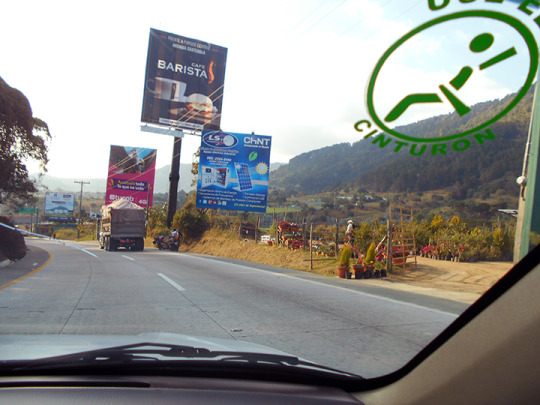
Shock absorber replacement shops must make a killing there because the roads are rough and there are many, many speed bumps. The change that occurs when you pull off the main highway into Antigua is abrupt. One minute you are looking at a long string of short, somewhat dirty stores, houses and billboards. The next you are enveloped in history because Antigua was the original capital of Guatemala until they experienced a major earthquake and decided it would be better to locate the capital somewhere else. As a result, the city has been preserved more or less just as it was in 1773, except of course for those buildings that were destroy. The full name of the city actually used to be Antigua Guatemala, which is Spanish for Old Guatemala. Some of the buildings date back to the 1500s, which is when the city was first built. Parque Central is, as you would expect, the centre of the city and the road to it is a long, straight tunnel of brightly coloured houses and shops. An artisanal pottery store sits next to a handmade furniture store. I don’t think it’s even possible to know how many hotels there are because many homeowners call themselves hotels when, in fact, they are really just B+Bs. Some people just call themselves casas and don’t even bother to advertise, but many do. They paint the word hotel on the outside of their house and voila, they’re a hotel. In short, there’s a plethora of places to stay, but since Antigua is the first and often the only place many Americans visit, you’d better book your room before leaving home. When our driver dropped us off at the park, he tried to collect our fares a second time, claiming that he hadn’t been paid by the man at the airport. The young man who was travelling alone told him that wasn’t his problem and walked away, so I did the same. I knew how to get to my “hotel” because I had looked it up on Google maps and memorized the route. This was necessary because no-one would be able to tell me how to find Casa de Maria. It has no sign and there’s a more well-known Casa de Maria, so I would only be misdirected if I asked for directions. Finding Maria’s house and getting checked in was the first order of business. I headed north on 5A Avenida taking note of the fact that the sidewalks there are much more narrow than the ones in Toronto, but this is true of every Guatemalan city. The sidewalks are very narrow, and cars rule. 5A Avenida is also the site of the city’s most iconic structure, The Santa Catalina Arch. This saffron-yellow structure was built in the 17th century and the purpose of it was to allow nuns to get from the convent to the school across the street. Their vow of seclusion meant that they couldn’t just walk across the street. Instead, they travelled back and forth via a secret tunnel contained with the arch. It is technically owned by the Guatemalan government, but managed by the people who own the convent, which is now a hotel called, you guessed it, El Convento. Leading up to the arch is a long string of restaurants, hotels, ice cream shops, currency exchange booths, souvenir shops, a chocolate museum, a clothing boutique, a store that sells jade jewelry and, of course, Guatemalan women selling brightly coloured blankets and purses from the sidewalk. You may even come across artist or two on the sidewalk, selling his paintings. Antigua is, in short, a tourist town with all the usual attractions that are geared towards travelers. Once you are past the arch, you may wish to turn around for a photograph of the arch with Volcan de Agua in the background.
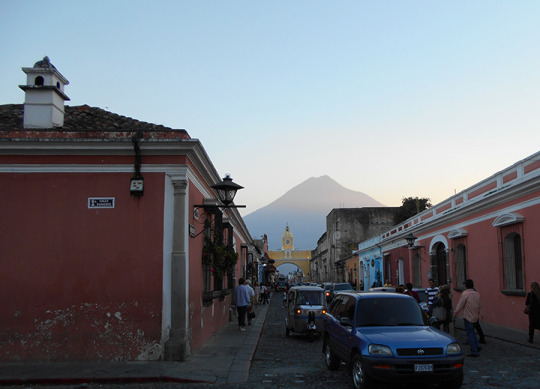
At the end of 5A Avenida, you come to Parque la Merced which has a spectacular yellow church attached to it.

The day I was there, several street food vendors were operating out of the park. I was quite tempted to sample their wares but had been advised against eating street food by the doctor who gave me my vaccinations. Since I didn’t want to contract Moctezuma’s revenge on the first day of my visit, I reluctantly chose to eschew their offerings. Casa de Maria is, as mentioned earlier, does not have a sign and it is also on a street called 1A Avenida de Chajon. This fact caused me to wander around in a circular loop on Calle de Chajon and 2A Avenida de Chajon until I finally realized that 1A Avenida was the street I wanted.
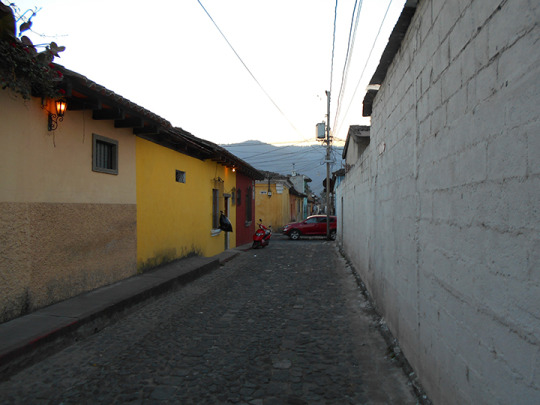
With only the address of the place to indicate that the bright yellow house might be the right place, I rang the doorbell, totally unsure that I would receive a friendly greeting. But it was the right place and a man who turned out to be a sort of caretaker, led me to the courtyard and told me that Maria was not there right at the moment. Nevertheless, he told me she would be there soon, and in the interim he could check me in and show me my room.
It wasn’t exactly a large room, but it wasn’t small either. It had two beds, a chest of drawers and a window that opened to the courtyard. Not bad for twenty bucks a night. And I had the use of the courtyard as well, where Maria’s dog slept on the tiled floor and her caged parrot kept a watchful eye. Within half an hour, Maria, herself, appeared and welcomed me. She explained that for a few quetzals extra, I could have a typical Guatemalan dinner which would be served at seven. I agreed to spend the extra money, told her I would return at seven and headed back out to the streets of Antigua.
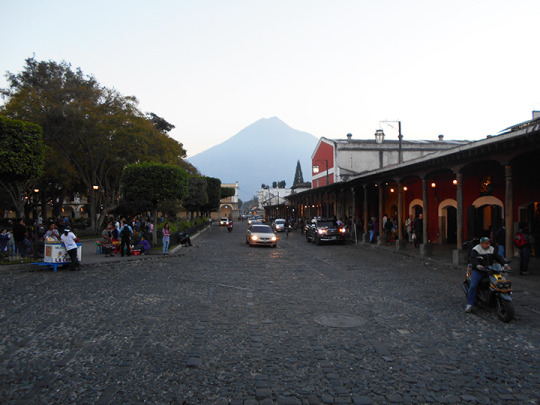
Parque Central is a lovely spot that follows the typical pattern for Guatemalan plazas. There’s a large cathedral on the east side and the Palacio de los Capitanes Generales at the south end. A long, low slung building on the west side is home to a variety of coffee shops and bars. To the north is another low slung building, built in the colonial style which houses a couple of restaurants and two banks, BAM (Banco Agromercantil de Guatemala) and BI (Banco Industrial). At the far eastern end is the two storied, multi-arch home of the city council, the Palacio del Ayuntamiento. The park itself is a lively, bustling spot with many people coming and going. Some people simply sit on one of the benches and watch the small but ornate water fountain doing its thing. It’s pretty much a guarantee that as soon as you enter, you will be approached by a woman selling blankets, or a young boy who wants to shine your shoes. Around the edges of the square, there are book stalls and men selling ice cream, or helados. It is not unusual to see much younger men selling peanuts out of a wheelbarrow. Occasionally, you will see a 14-year-old boy pushing a larger more complicated wheelbarrow with multiple compartments for cashews, pistachios, raisins and various other offerings that you may or may not recognize.
Seeing as how it was a lovely, warm afternoon, I decided to sit in the park and absorb the atmosphere of the place. I was approached by three or four women selling blankets and simply shook my head. “No, gracias,” is a phrase one uses a lot in Guatemala. The fourth woman to approach me was a little more persistent.
“For your wife,” she said, holding up a blanket.
“No, gracias,” I replied. “I don’t have a wife.”
“For your friends, then.”
“I don’t have any friends, either,“ I lied.
“For your enemies?”
“No gracias.”
She made me laugh, but it is actually a common patter amongst blanket sellers, wife, friends, enemies. Other types of sellers came and went. People selling watches, children’s toys and a variety other novelty items. I didn’t have a plan for the rest of the afternoon, so I simply walked down to the end of 5A Avenida Sur, marveling at the sight of Volcan de Agua in the distance, turned around and retraced my steps back to Reilly’s Irish Tavern. It’s not a place I would usually go to, but I figured by the name that I wouldn’t need any Spanish in order to get a beer or two. It turned out to be a fairly unassuming place, with a square, well-stocked bar in the middle of a large room, walls painted with over-sized Guiness labels, Gallo on tap and only a handful of customers. One thing I appreciated about the place was that I could drink my beer and watch people outside walk past the open doorway.
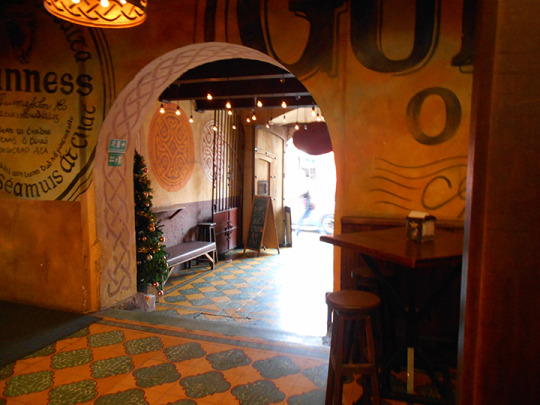
I’m sure it would have been much livelier later in the evening, but I had to get back to Maria’s for dinner. It was a pleasant, warm evening and the streets were filled with people wending their way home from work. The food trucks at Parque Merced were in full swing and surrounded by small clusters of hungry customers. Motorcycles and cars throbbed relentlessly down the cobblestone streets. I rang the bell at Casa de Maria and was ushered in a few seconds later. Maria greeted me with, “Hola, Senor Frederico! Are you ready for dinner?” I was. It was chicken with black beans and salad, quite tasty and well worth the five quetzals I was going to pay for it. Across the courtyard a young couple were also eating dinner and, to my eye, appeared quite bored with one another, preferring to surf the net on their phones than engage in actual conversation. Maria’s parrot was already asleep as evidenced by the towel covering its cage. The setting of the sun became apparent as the light from the sky above gradually dimmed on the wall to my left. The temperature dropped dramatically, so I finished my meal quickly and walked down the short hallway behind me to my room. Making an early night of it was not going to be a problem. It had been a very long day and I was too exhausted to even consider going out to sample Antigua’s nightlife. I made a mental list of things to do the next day, visiting the old cathedral being the first order of business. I turned out the light, crawled between the blankets and fell asleep listening to the murmuring voices that were coming through the window from the courtyard.
----------------------------------------------------------------------------------------
To purchase Going to Guatemala as an instant download PDF, click here.
To visit Lost City Press, click here.
0 notes
Text
The Doris McCarthy Trail
window.dataLayer = window.dataLayer || []; function gtag(){dataLayer.push(arguments);} gtag('js', new Date()); gtag('config', 'UA-13221846-3');
One of Toronto’s features that the city’s boosters like to promote is ravines. Toronto has many ravines and people often say that, in order to feel like you have left the city behind, all you need do is go down into one. It’s kind of true, but, with a few notable exceptions, you never really feel that you are completely out of the city. You feel that you are in a small, natural setting outside of which is an urban Gargantua. One notable exception, and it’s one that I only recently discovered, is the Doris McCarthy Trail.

Doris McCarthy was a Canadian artist who lived nearby, in a large house on top of the Scarborough bluffs called Fool’s Paradise. There is also a piece of artwork called Passages at the end of the trail which was commissioned by The Friends of Doris McCarthy. Apparently, she also donated two hectares of the ravine to the Toronto and Region Conservation Authority, so it seems appropriate that they named the trail after her. To get to the trail head, take the 102 Bus from Warden Station and get off at Kingston Road and Bellamy, in front of the Pioneer gas station. They sell soft drinks and snacks inside so if you haven’t brought any refreshments, you can stock up there. A large bottle of water is the minimum I’d suggest having with you. If it’s a warm day you’re going to be guzzling it like crazy on the way back up the trail. There really isn’t any obvious place to park, so, in this case, public transit really is the better way. Simply walk from the gas station down Ravine Drive for about two hundred feet and you will see the entrance to the trail.
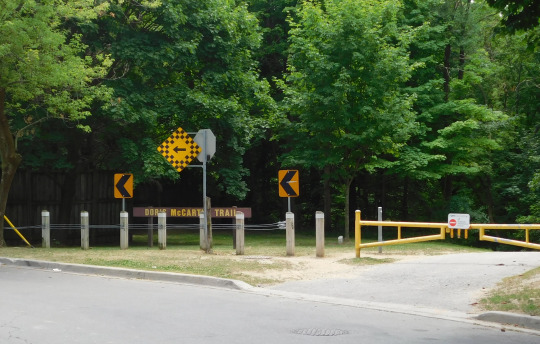
I guess I should mention that riding a mountain bike down the trail seems to be acceptable to the powers that be because there are signs advising cyclists to walk down the steeper sections.
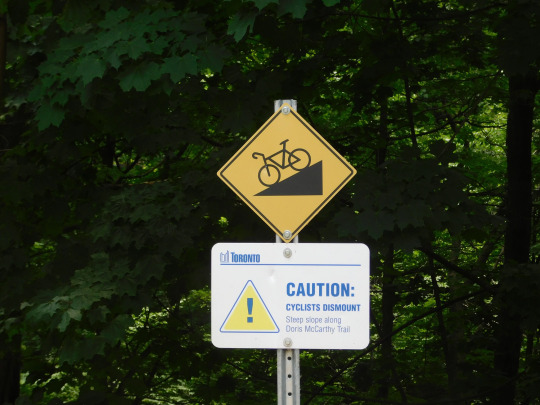
The problem with that is getting back up. Even in your lowest granny gear, it’s going to be a tough slog and you’re pretty much eliminating your chances of seeing any foxes or other wildlife. Once past the barricade, you will find that the path immediately plunges downward and you are, seemingly, enveloped in nature.

Bellamy Ravine Creek or brook burbles to your right over what is obviously a series of man-made cascades, installed, presumably, to keep the newly upgraded trail from being washed away by spring run-off. I believe the trail had to be closed recently due to just such an event. So okay, it’s not 100% natural, but it’s close enough. You’re completely enveloped in a deciduous forest and there is nothing to remind you that the houses on Bellehaven Crescent are only a few hundred feet away, even though they are.
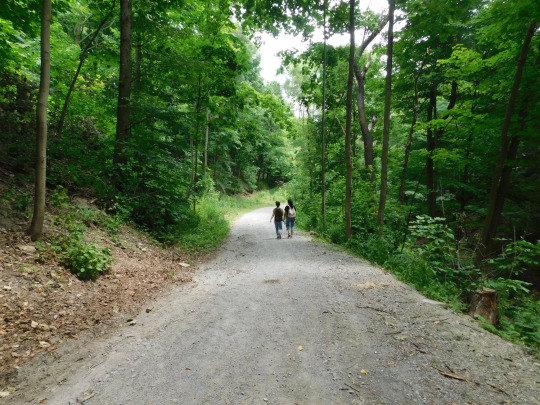
You might find it interesting to reflect upon the fact that you are following a path used by natives as long ago as 8,000 B.C. This is known, apparently, because some arrowheads dating to that period were found in the ravine. Corroboratory evidence of there being large numbers of natives in the area, prior to the arrival of European settlers, is the Tabor Hill Ossuary just 4.5 kilometeres to the north. Dating to the 1400s it is estimated to contain the remains of 472 Wendat natives. Two kilometres to the west, on the north shore of Highland Creek, was the village, four hectares large, that these people lived in. Both the ossuary and the village were excavated in 1956 by archaeology students from U of T.

If smuggling and skullduggery are more your cup of tea, then you might choose to imagine all manner of illegal imports from the United States being brought up this path as recently as the 1830s, tea and tobacco being two of the most popular products. It might seem harmlessly romantic, but getting caught could result in hanging, so smugglers would sometimes dump their entire cargo overboard if they thought there was a chance of that happening.

And then there’s the gold. It is said that, during the war of 1812, American soldiers buried some looted gold here in the ravine, and it was never recovered. Highly unlikely, but the story does add to the trail’s allure. Primarily, however, the Doris McCarthy Trail is a nature trail that takes you down through a cleft in the Scarborough Bluffs to the shore of Lake Ontario.

Enjoy the lush forest, the birdsong, the burbling brook and the blue sky overhead if have been so fortunate. About two thirds of the way down you may begin to notice a slightly strange phenomenon. The horizon of Lake Ontario appears to too high in the sky. This is, I think, an optical illusion of sorts caused by the fact that you are still fairly high above the shoreline but still looking straight out at the horizon. Or maybe it’s just me. Have a look and see what you think.

When you reach the bottom of the path, you are presented with a piece of artwork called Passages. Depending on your point of view it either looks like the rib cage of a large fish or the hull of a boat.
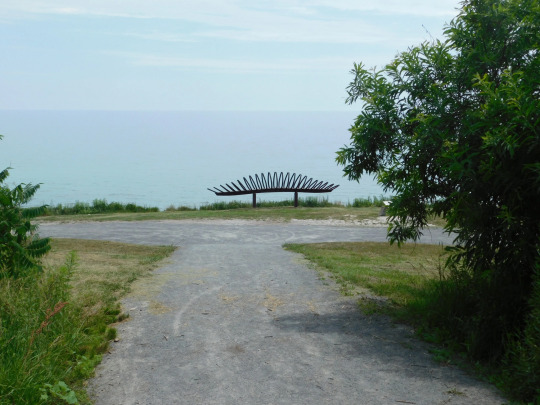
Maybe you see something else. In any case, it’s meant to commemorate the life of Doris McCarthy and place that life within the much larger context of the bluffs, which, as the explanatory plaque will tell you, were formed 23,000 years ago.

In fact, if you just look at the layers of clay and silt in the bluffs you can see the history of how they were formed. The top layer is glacial till, a hodge podge mixture of everything the ice sheet has ground up on its way south, but basically clay and small boulders.
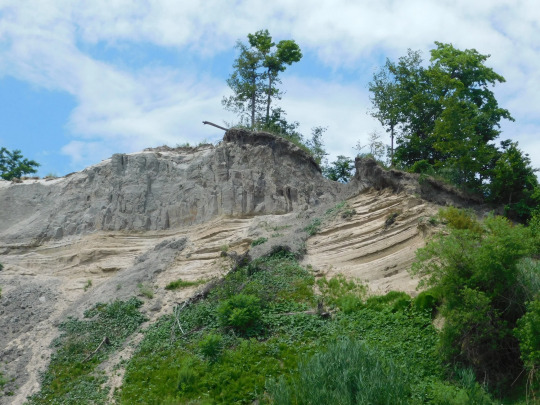
It’s easy to tell the difference between this and the layer of sediment below it because the lines in the till are vertical and the lines in the sediment are horizontal. To get a sense of how old the layers of till and sediment at the bottom of the bluffs are, start with the top layer of till. It was deposited here somewhere between 25,000 and 40,000 years ago.
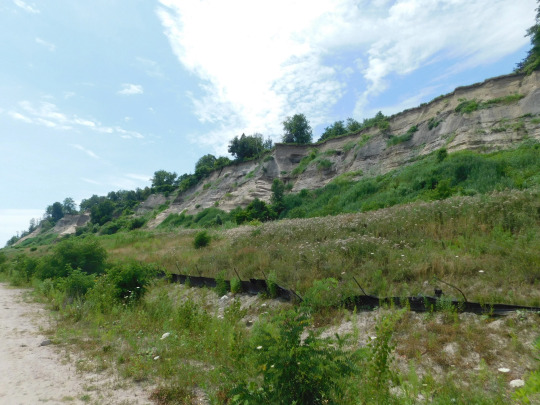
Then realise, as you scan down the cliff face, that each succeeding layer was deposited much earlier. What you can see at the bottom was left there as long ago as 2.5 million years maybe. In between the time the bottom and top layers were deposited, woolly mammoths inhabited the region. The bluffs, in short, are really old and were formed over a long period of time. Their erosion, however, has taken place over a much shorter period, 1.62 feet each year. Scant wonder then that a summer house built on the edge of one of the properties above has almost fallen right off that edge. Ironically enough, it used to belong to a comedian called Billy Van who starred in a TV series called The Hilarious House of Frankenstein. So, if you think the city has destroyed the natural look of the area at the base of the bluffs with its new breakwaters, I would encourage you to spare a thought for the poor homeowners on top of them. How did they know that by building a string of monster homes right next to an eroding cliff they were being perhaps overly optimistic. Seriously though, the breakwaters were obviously needed to slow down the rate of erosion and allow future generations of Torontonians the opportunity to marvel at this geological wonder.

Once you have satisfied your curiosity about Passages, there are two directions you can head, obviously. To the west lies a long service road which will eventually (a little less than a kilometer) bring you to Bluffers Park Beach, where you can lie in the sand and maybe even go for a wade in the water.

To the east, the path stretches out a good long ways along the shore, but just remember, for every kilometre you hike in that direction, you’re going to have to come back to Passages and then hike back up the hill to the bus stop. One particularly interesting thing to see in this direction is only a couple of hundred metres away, however. It’s the remains of the steamship Alexandria, which ran aground here in 1915. All the passengers on board escaped and climbed up Gates Gully to Kingston Road. If you walk to the first rock protrusion of the breakwater, you should be able to see the top of the ship’s smoke stack because the waves break over it.

So that’s pretty much all there is to this outing. A nice walk in nature. Some historical and artistic curiosities. And couple of million years of geology. The day of my visit, there was one more thing to take note of. Turkey vultures, aka buzzards. These birds have an awesome wing span, five-and-a-half to six feet in length, which allows them to ride the updraft at the top of the bluffs. Only occasionally do they need to flap their wings to stay aloft. And what are they looking for while they circle? Dead squirrels. The occasional seagull carcass. Washed up fish and the like. Just anything that’s already dead but not yet in a state of putrefaction. Even a buzzard has to have some standards. The thing about these buzzards, however, is that they could also serve as a nice exclamation mark at the end of some kind of sentence about the brief, transitory nature of all living things, while they circle over a 2.5 million year old cliff face looking for their next meal.

To get back to Kingston Road and the bus back to Warden Station, simply trudge your way back up Gates Gully. Take your time, and rest as often as you need to. If it helps, you can imagine yourself being a smuggler in the early Victorian era with a big payout waiting for you at the top.
2 notes
·
View notes

